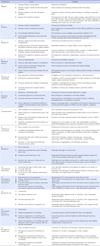Abstract
Purpose
The purpose of this study was to develop a patient classification system based on nursing care intensity for patients with acute stroke-related symptoms and verify its validity and reliability.
Methods
Data were collected between November, 2013 and February, 2014. The verification for content validity of the patient classification system was conducted by a group of seven professionals. Both interrater reliability and concurrent validity were verified at stroke units in tertiary hospitals.
Results
The intensive nursing care for acute stroke patients consisted of 14 classified domains and 56 classified contents by adding 'neurological assessment and observation' and 'respiratory care': 'hygiene', 'nutrition', 'elimination', 'mobility and exercise', 'education or counselling', 'emotional support', 'communication', 'treatment and examination', 'medication', 'assessment and observation', 'neurological assessment and observation', 'respiratory care', 'coordination between departments', and 'discharge or transfer care'. Each domain was classified into four levels such as Class I, Class II, Class III, and ClassIV.
Figures and Tables
Table 3
Final Patient Classification System in Stroke Unit

NIHSS=National institute of health stroke scale; NPO=Nothing per oral; ECG=Electro cardiogram; ICU=Intensive care unit; CT=Computed tomography; ERCP=Endoscopic retrograde cholangiopancreatography; IV=Intravenous; V/S=Vital sign; BP=Blood pressure; I/O=Input/output; U/O=Urinary output.
ClassI: 14~20, ClassII: 21~34, ClassIII: 35~48, ClassIV: 49~56 point.
References
1. Clarke MF. Exploration of nursing intensity in a sample of acute care cardiovascular patients using the nursing interventions classification (NIC) [dissertation]. Iowa: University of Iowa;2006.
2. Clarke SP, Aiken LH. More nursing, fewer death. Qual Saf Health Care. 2006; 15(1):2–3. http://dx.doi.org/10.1136/gshc.2005.017343.
3. Van den Heede K, Clarke SP, Sermeus W, Vleugels A, Aike LH. International experts' perspectives on the state of the nurse staffing and patient outcomes literature. J Nurs Scholarsh. 2007; 39(4):290–297. http://dx.doi.org/10.1111/j.1547-5069.2007.00183.x.
4. Upenieks VV, Kotlerman J, Akhavan J, Esser J, Ngo MJ. Assessing nursing staffing ratios: Variability in workload intensity. Policy Polit Nurs Pract. 2007; 8(1):7–19. http://dx.doi.org/10.1177/1527154407300999.
5. Song KJ, Kim EH, Yoo CS, Park HO, Park KO. Development of KPCS (Korean Patient Classification System for Nurses) based on nursing needs. J Korean Clin Nurs Res. 2009; 15(1):5–17.
6. Kim EH, Park JH. Reliability and validity tests of patient classification system based on nursing intensity. J Korean Acad Nurs Adm. 2007; 13(1):15–16.
7. Park JH, Song MS. Determination of nursing costs for hospitalized patients based on the patient classification system. J Korean Acad Nurs. 1990; 20(1):16–37.
8. Korean Nurses Association. A study of the optimal nursing manpower based on patient classification system. Taehan Kanho. 1992; 31(3):88–103.
9. Cho YA, Shin HJ, Cho JK, Jung MK, Lee BN, Song KJ. Development and application of the workload management system for critical care nurses (WMSCN) using WMSN. J Korean Clin Nurs Res. 2005; 11(1):71–84.
10. Galimberti S, Rebora P, Di Mauro S, D'llio I, Vigano R, Moiser C, et al. The SIPI for measuring complexity in nursing care: Evaluation study. Int J Nurs Stud. 2012; 49:320–326. http://dx.doi.org/10.1016/j.ijnurstu.2011.09.016.
11. Koh BJ, Yoo M, Kang JS, Kim DY, Park SJ, Oh SJ, et al. A study on identifying standard nursing practice time for developing a neonatal patient classification system in neonatal intensive care unit. Seoul: Hospital Nurses Association;2009.
12. Kim MS, Kim MK, Song WJ, Lim EJ, Kim HJ, Lim HS, et al. Classification on patient severity score among hemodialysis patients. J Korean Clin Nurs Res. 2008; 14(1):161–172.
13. de Jong AEE, Leeman J, Middelkoop E. Development of a nursing workload measurement instrument in burn care. Burns. 2009; 35:942–948. http://dx.doi.org/10.1016/j.burns.2009.04.005.
14. Panunto MR, Guirardello EB. Nursing workload at a gastroenterology unit. Rev Lat Am Enfermagem. 2009; 17(6):1009–1014. http://dx.doi.org/10.1590/S0104-11692009000600013.
15. Gross JC, Goodrich SW, Kain ME, Faulkner EA. Determining stroke rehabilitation inpatients' level of nursing care. Clin Nurs Res. 2001; 10(1):40–51.
16. Frilund M, Fagesrstrom L. Validity and reliability testing of the Oulu patient classification: Instrument within primary health care for the older people. Int J Older People Nurs. 2009; 4:280–287. http://dx.doi.org/10.1111/j.1748-3743.2009.00175.x.
17. Statistics Korea. 2012 Cause of death [Internet]. Seoul: Author;2012. cited 2013 December 15. Available from: http://kostat.go.kr/portal/korea/kor_nw/2/6/2/index.-board?bmode=read&bSeq=&aSeq=308559.
18. Stacy KM. Progressive care unit: Different but the same. Crit Care Nurse. 2011; 31(3):77–83. http://dx.doi.org/10.4037/ccn2011644.
19. Stroke Unit Trialists' Collaboration. Organised inpatient (stroke unit) care for stroke. Cochrane Database Syst Rev. 2013; 9:CD000197. http://dx.doi.org/10.1002/14651858.CD000197.pub3.
20. Ko YC, Han MK, Kim WJ, Kwon OK, Oh CW, Jung Ck, et al. Differences of mortality and dependence between stroke unit and general ward care in acute ischemic stroke patients. J Korean Neurol Assoc. 2009; 27(2):116–122.
21. Oh HS, Seo HS, Park JS, Bae EK, Lee SJ, Jung YY, et al. Criterion-related validity of the critical patients' severity classification system developed by the hospital nurses' association. J Korean Acad Adult Nurs. 2009; 21(5):489–503.
22. Radtke A. Telemetry monitoring: A preferred solution for intermediate care. Nurs Manage. 2006; 37(12):52A–52B.
23. Hoi SY, Ismail N, Ong LC, Kang J. Determining nurse staff needs: The workload intensity measurement system. J Nurs Manag. 2010; 18:44–53. http://dx.doi.org/10.1111/j.1365-2834.2009.01045.x.
24. Jung JH. A study on estimation of the appropriate nursing personnel demands for medical and surgical ICUs in a tertiary hospital [master's thesis]. Seoul: Seoul National University;2000.
25. Park JH. A study on the determination of nursing cost for hospitalization based on Korean diagnosis related groups (K-DRGs) in Korea [dissertation]. Seoul: Ewha Womans University;1988.
26. Hospital Nurses Association. A study on estimation of nursing costs by a nursing workforce grade and a patient classification system (PCS)-both in general ward and in ICU. Annual report. [Internet]. Seoul: Author;2003. cited 2013 March 12. Available from: http://khna.or.kr/web/information/resource.php.
27. Yang MH. A study of investigating the efficacy of stroke unit for acute stroke patient management in terms of mortality, DALY and modified rank in scale score: Experience from a comprehensive stroke center in urban area of South Korea [master's thesis]. Seoul: Korea University;2012.
28. Clinical Research Center for Stroke. Clinical practice guidelines for stroke [Internet]. Seoul: Author;2013. cited 2013 March 22. Available from: http://www.stroke-crc.or.kr/popup_090513.html.
29. Nam TS, Park JG, Choi SM, Lee SH, Park MS, Kim BC, et al. Behavioral and psychological symptoms following acute middle cerebral artery infarcts. Journal of Korean Neurological Association. 2005; 23(2):152–157.




 PDF
PDF ePub
ePub Citation
Citation Print
Print





 XML Download
XML Download